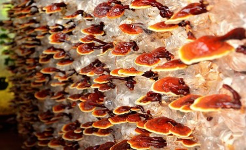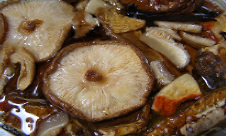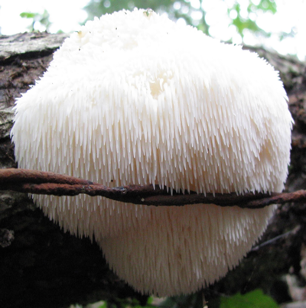“Mushrooms are miniature pharmaceutical factories, and of the thousands of mushroom species in nature, our ancestors and modern scientists have identified several dozen that have a unique combination of talents that improve our health”.
(Quote by Paul Stamets, (2011)

It’s surprising what mother nature gives us as a means of keeping us healthy. Have you ever considered the medicinal benefits of mushrooms?
Disclaimer
Before we take a closer look, as always, seek medical attention or advice before pursuing any natural remedies and this blog is NOT about diagnosing any condition or even saying the following products will be right for you. So please use your own judgement and common sense especially if pregnant, nursing or on other pharmaceutical medication. Nor have I received any payment from the below mentioned companies.
Also, it is extremely dangerous to pick your own mushrooms as there are many which are poisonous and can result in death. We are not advocating you do this. We would advise you buy from a reputable source as an alternative.
What are Mushrooms exactly?
Encyclopaedia Britannica, (2020) explains mushrooms are…..”…..edible sporophores…. fleshy fungus fruiting structure of fields and meadows….” Paul Stamets, (2011) explains there are an estimated 2-4 million species of ‘fungi’, with 150,000 thought to be mushroom-forming fungi, although only 14,000 species are formally identified.

Ancient History
Mushrooms used for medicinal purposes is not a new concept as revealed by the frozen human mummified remains of Ötzi, found on the Ötztal Alps on the Austrian–Italian border in 1991. Ötzi is believed to have died around 3300 BCE, and amongst his remains were Birch Fungi, known for their Anthelmintic properties, (Capasso, 1998), and the ability to expel parasitic worms and other internal parasites from the body.
Egyptian Hieroglyphics suggest society saw mushrooms as a plant of immortality, (Grocycle, no date). They would also apply a poultice of mouldy bread to infected wounds, (ACS, 1999).
Texts about Chinese Medicine dating as far back to 100 BCE discuss various mushrooms and fungi that were used to treat cancer, respiratory ailments, and many other conditions, (Grocycle, No date).
Modern Times
Whilst not all mushrooms are edible, culinary mushrooms such as Shiitake, Maitake, Oyster, Enoki, Shimeji, and Pioppinos are low in fat, have no cholesterol and are rich in vitamins, so from a nutritional viewpoint, help with boosting the immune system, (Stamets, 2011).

It’s interesting to note the medicines available to us these days such as antibiotics. It is mind boggling to think that as little as a hundred years ago, if you developed a bacterial infection such as Pneumonia or blood poisoning from a simple scratch, the chances were, you may well have died. The discovery of Penicillin by Alexander Fleming in 1928 changed how we treat infections, when he identified the healing properties of ‘mould juice’, (ACS, 1999).
Mycologists, (people who study Fungi) and other types of scientists are now starting to understand how mushrooms can offer safer alternatives to many modern pharmaceuticals.
Here are some of the more popular benefits.
Antiviral, and Antibacterial Properties
Like all live moulds and fungi, they are a food source, so as a means of staving off being eaten or to fight off bacteria which may kill them fungi produce toxins to protect themselves. It is these toxins that can act as natural antibiotics in our bodies when we consume them.
High in Antioxidants
UV sunlight, inflammation, air pollution, and smoking all contribute towards Free Radicals that can cause oxidative stress and damage to our cells and DNA. Mushrooms contain antioxidants which seek out free radicals and thus diminish the damage they cause. I view them a bit like Batman seeking out villains in Gotham City!!
Beta Glucan:
is a substance that helps to stimulate the immune system.
Polysaccharides Compounds:
found in mushrooms are known to offer anti-cancer, anti-obesity,
anti-diabetes, and antibiotic properties.
Health Benefits
As we have mentioned above, there are a huge range of mushroom types, but generally the health benefits include the following:
- Help prevent DNA damage, cell mutation, and tumour formation so aid fight against cancer and Leukaemia
- Loaded with antiviral and antibacterial properties so are good for boosting your Immune System
- Contain natural ‘Statins’, the compound used to lower blood cholesterol that can cause hardening of the arteries, thus can protect against heart attacks, strokes and heart disease.
- Improving Energy Levels due to compounds that increase the flow of oxygenated blood cells to muscles, clearing toxins from the body that otherwise can leave you feeling tired.
- improving Brain Health by producing nerve growth in the brain, to improve memory, focus and cognitive functioning.
- Low in fat and calories, so a diet high in mushrooms can aid weight loss (which brings with it its own health benefits)
- Has a hypoglycaemic effect, meaning they lower and regulate blood sugar levels, good for diabetes
- Mushrooms inhibit histamine release so are good for relieving symptoms of asthma or allergies
Some Basic Types And To Use Them
Some of the more popular and well known ‘healthy’ mushrooms are:
Reishi Mushrooms which grow on the side of trees, they are too bitter to eat, but their Terpenoids compounds mean they are good for reducing inflammation. They also help with heart disease, cancer, diabetes and liver damage to name few.

Consumed either in soup or made into a tea, they are usually dried and come in either powder or capsule form.
Chaga Mushrooms grow on Birch Trees, (not to be confused with Birch Fungi found on our Ötzi man). Come across this and you would be forgiven for thinking it is charred wood as it looks more like charcoal, again not edible in its natural state.

Often combined with other mushrooms, Chaga can be consumed as herbal tea, in a powder or capsule form. Its healing properties are believed to aid the fight against cancer, improve immunity, chronic inflammation, blood sugar and reduce cholesterol levels.
Maitake Mushrooms
Unlike the above two, Maitake Mushrooms are edible and are said to have a mild flavour and grow at the bottom of Oak, Elm, and Maple trees, normally found in parts of Japan, China, and North America.

Maitake are a good candidate for all of the above health benefits but are also useful for fighting cold and flu viruses, managing both high and low blood pressure, boosting immune function and reducing side effects of chemotherapy. You can add to any meals such as salads, stir fry, pasta and also be taken in either liquid or capsule form.
Cordyceps Mushrooms
For an unknown reason, I like the word Cordyceps, just thought, I’d throw that snippet of useless information in there! Cordyceps is considered to be a ‘parasitic’ fungus in as much as its spores attach to the larvae of insects such as ants and caterpillar’s.

It feeds and sprouts on its host insect growing into a mushroom and remains attached for most of its life, growing mainly in high altitude regions of about 3800 m above sea level, in cold, grassy, alpine meadows of the Himalayan mountains. So evidently not the edible type!
Cordyceps is known to enhance energy, aerobic capacity (breathing), reduce fatigue, anti-sickness, promotes health kidney function and can even boost low sex drive! You can buy cordyceps in tinctures, liquid extracts, capsules, and powders.
Shiitake Mushrooms
Thanks to Catherine Tate, Shiitake mushrooms are probably one of the more well known, edible variety. Native to East Asia, Shiitake grow on decaying hardwood trees in United States, Canada, Singapore, China, with 83% of the worlds production coming from Japan. Coming in dried and fresh varieties shiitake mushrooms can be used in dishes such as stir-fries, soups and stews

Benefits include being antibacterial and antiviral, fight infections, cancer, strengthen bones, reduce high blood pressure. They also come in powders, capsules and liquid format.
Turkey Tail Mushrooms
Growing on almost any type of wood, these mushrooms can be found in woodlands all over Europe and China. The tend to grow in colonies and their black, brown shades of thin, wavy rosettes bodies take on a similar appearance of the plumage of a turkey’s tail, hence its name!

Although edible, they are known to be very chewy, so powder or capsule form tends to be the most common. Turkey Tail Mushrooms are said to be useful in reducing phlegm, increasing energy, helping with pulmonary problems, promoting a healthy liver, boost immune system, effective in managing diabetes and reducing inflammation.
Lion’s Mane Mushrooms
Doesn’t take much guess work to understand how this mushroom gets its name. Its large, shaggy white appearance resembles a lion’s mane. Edible, some describe its flavour as akin to crab or lobster and can be eaten raw, cooked, dried or steeped as a tea.
They grow on hardwoods such as oak, maple and birch, found in Europe, North America, Japan, China and Korea.

Lion’s main mushrooms are believed to promote mental wellbeing, reduce symptoms of depression, slow down signs of memory loss and reduced cognitive functioning, promote good digestive health, reduce risks associated with heart disease, beneficial for diabetes, reduce inflammation, fight against cancer and boosts immune system. Primarily capsule form, but is also available as a powder.
Conclusion
Its astonishing how beneficial mushrooms are said to be. I can remember drinking mushroom infused coffee and whilst it does sound pretty gross, actually it tasted ok. There is a range of products on the market these days and I have to say one of my favourite brands has to be Vida Divina. This is because I have had close links with the company for a few years now so have a good understanding of their products which is what got me interested in the concept of mushrooms for promoting good health. But having said that there are other companies and products available.
Given their general ability to the boost immune system, reduce inflammation as well as having antibacterial and antiviral properties I would say we are onto a winner with these.
If you’d like to grow your own mushrooms there’s some great advice here
Much Love Lisa


Health Benefits of Mushrooms blog
By Lisa Watson,
Co-author, How to Thrive in Professional Practice: A Self-care Handbook available for pre-order here www.criticalpublishing.com/how-to-thrive-in-professional-practice
Further reading
I came across some really useful websites if you wanted to take a closer look at the mushrooms mentioned above, a lot of which I have used as references:
https://www.healthline.com/health/food-nutrition/maitake-mushroom
https://www.drweil.com/vitamins-supplements-herbs/herbs/maitake/
https://www.healthline.com/nutrition/chaga-mushroom
https://www.healthline.com/nutrition/reishi-mushroom-benefits#section7
https://www.ncbi.nlm.nih.gov/pmc/articles/PMC3121254/ (Cordyceps)
https://www.healthline.com/nutrition/cordyceps-benefits#section2
https://www.healthline.com/nutrition/shiitake-mushrooms
https://www.healthline.com/nutrition/turkey-tail-mushroom
https://www.healthline.com/nutrition/lions-mane-mushroom
I also came across an article about immune boosting as whole
https://www.healthline.com/nutrition/immune-boosting-supplements
If you wanted to check out Vida Divina products more, you can visit their website: https://vidadivina.com/
References
Alexander Fleming Image https://media.gettyimages.com/photos/prof-alexander-fleming-working-in-laboratory-picture-id50489701?s=612×612
American Chemical Society, (1999) Discovery and Development of Penicillin https://www.acs.org/content/acs/en/education/whatischemistry/landmarks/flemingpenicillin.html
Birch Fungi Image https://www.norfolkwildlifetrust.org.uk/wildlife-in-norfolk/species-explorer/fungi/birch-polypore
Capasso, L. (1998), 5300 Years Ago, The Ice Man Used Natural Laxatives And Antibiotics, Lancet, 352 (9143): 1864
Cordyceps Mushroom Image https://upload.wikimedia.org/wikipedia/commons/5/53/2010-08-06_Cordyceps_militaris_1.jpg
Encyclopaedia Britannica, (2020) Mushroom, Fungus https://www.britannica.com/science/mushroom
Grocycle, (No date) Medicinal Mushrooms: The Complete Guide https://grocycle.com/medicinal-mushrooms-the-complete-guide/
Lion’s Mane Mushrooms Image https://medicinalherbals.net/wp-content/uploads/2016/09/Lions-Mane-Mushroom.jpg
Maitake Mushroom Image https://cdn.drweil.com/wp-content/uploads/2016/09/vitamins-supplements-herbs_herbs_maitake_20090976.jpg
Paul Stamets Interview with Patricia Fitzgerald, www.huffingtonpost.com. November 2, 2011. https://www.huffpost.com/entry/mushrooms-breast-cancer_b_1070744

